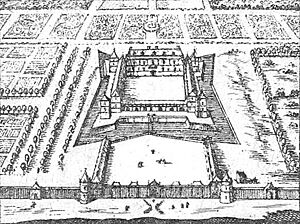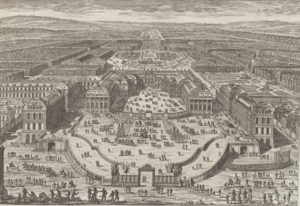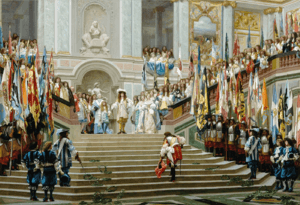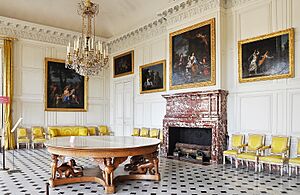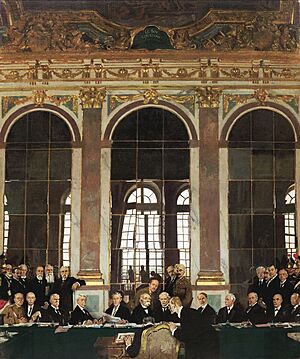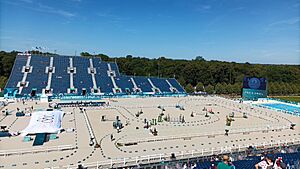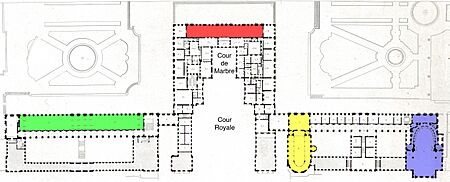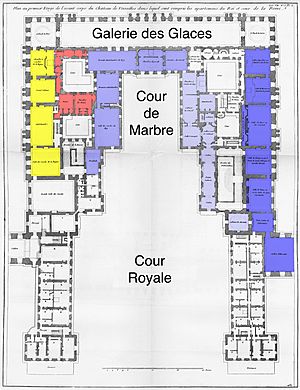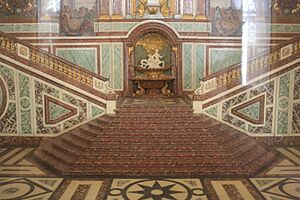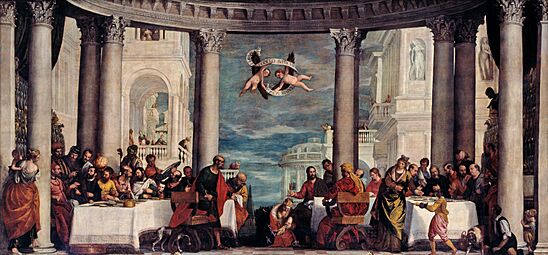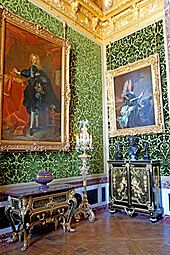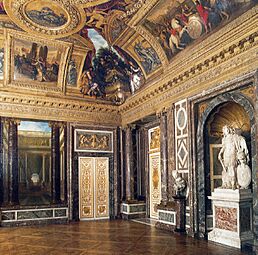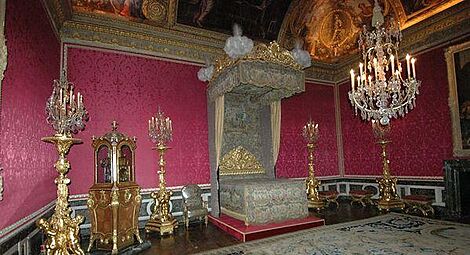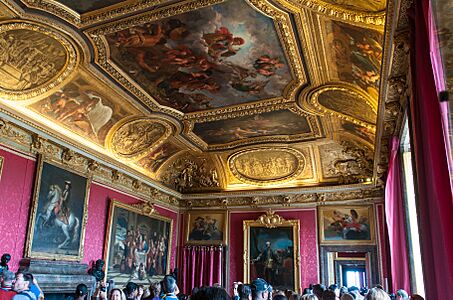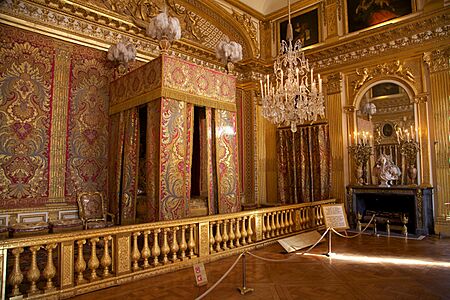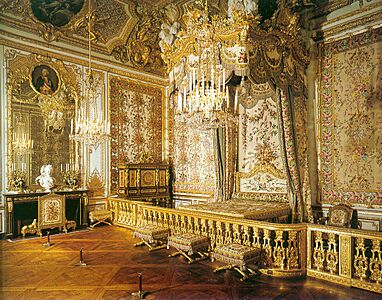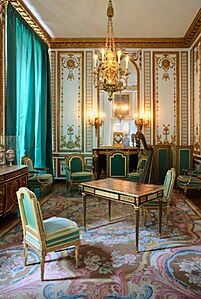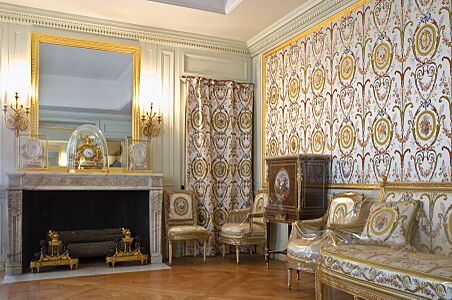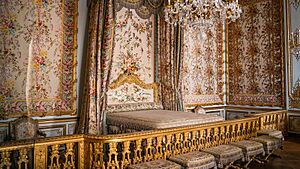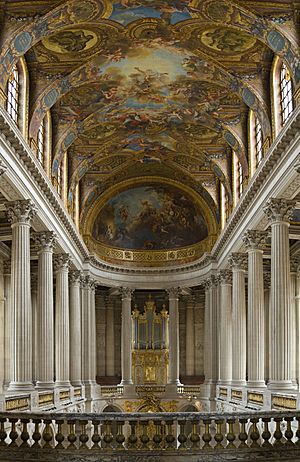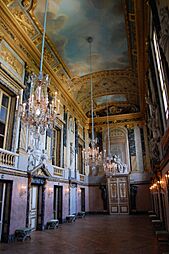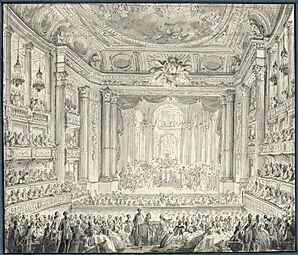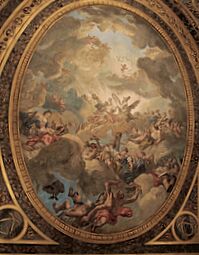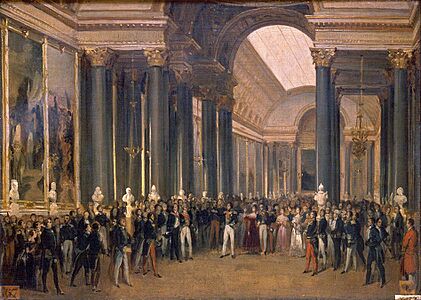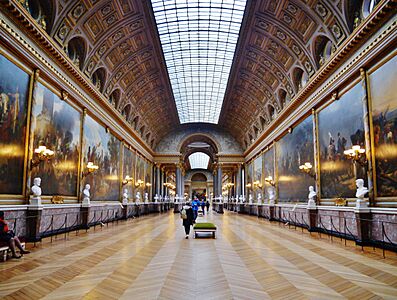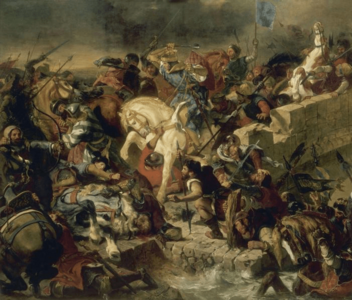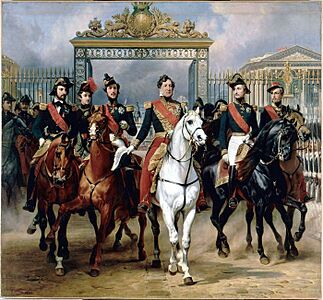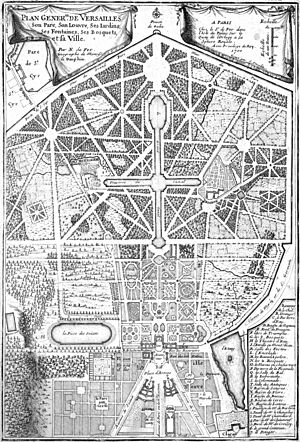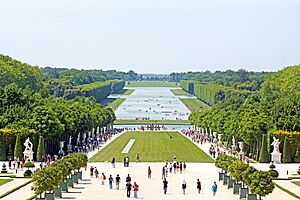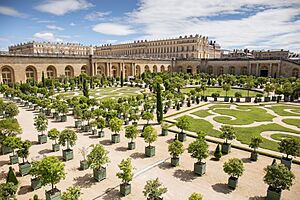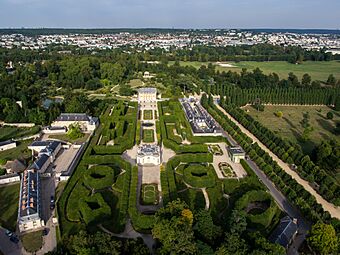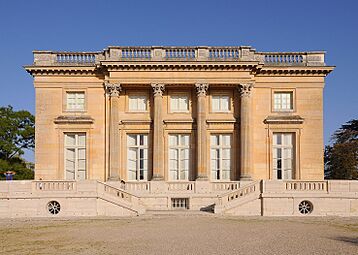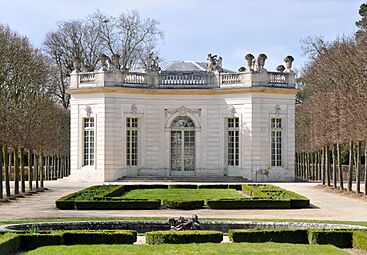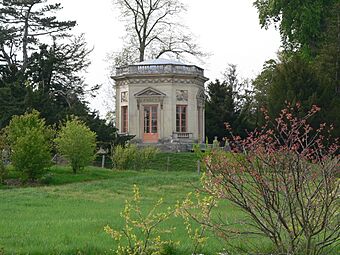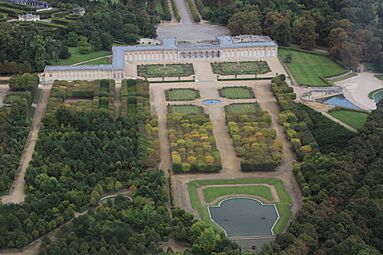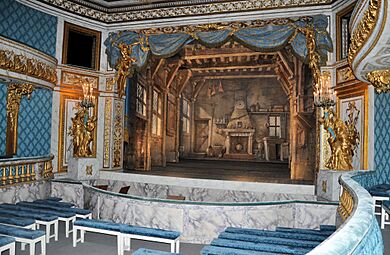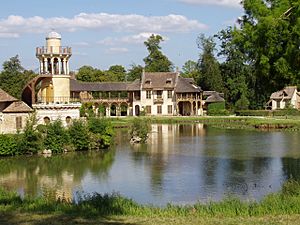Palace of Versailles facts for kids
Quick facts for kids Palace of Versailles |
|
|---|---|
|
Château de Versailles (French)
|
|
|
Garden façade and fountains; Hall of Mirrors
|
|
| General information | |
| Architectural style | Classicalism and Baroque |
| Location | Versailles, France |
| Coordinates | 48°48′17″N 2°7′13″E / 48.80472°N 2.12028°E |
| Construction started | 1661 |
| Owner | Government of France |
| UNESCO World Heritage Site | |
| Official name | Chateau and Park of Versailles |
| Criteria | Cultural: i, ii, vi |
| Inscription | 1979 (3rd Session) |
| Area | 800 ha (2,000 acres) |
| Buffer zone | 9,467 ha (23,390 acres) |
The Palace of Versailles is a super famous former royal home in Versailles, France. It's about 18 kilometers (11 miles) west of Paris. Imagine a huge, fancy palace where kings and queens once lived!
The French government owns the palace today. It's managed by a special group under the French Ministry of Culture. Every year, about 15 million people visit the palace, its park, or its amazing gardens of Versailles. This makes it one of the most popular places to visit in the world!
King Louis XIII first built a hunting lodge here in 1623. Later, his son, King Louis XIV, turned it into the giant palace we see today. He kept adding to it from 1661 to 1715. Both kings loved living there. In 1682, Louis XIV even moved his entire government to Versailles. This made the palace the unofficial capital of France. Kings Louis XV and Louis XVI also lived here, mostly changing the inside of the palace. But in 1789, the royal family had to return to Paris. During the French Revolution, the palace was mostly empty and its treasures were taken away.
Later, Napoleon used a smaller palace nearby, called Grand Trianon, as a summer home. But he didn't use the main palace. In the 1830s, the palace finally got some much-needed repairs. A museum of French history was created inside, replacing some of the old royal apartments.
In 1979, UNESCO named the palace and its park a World Heritage Site. This means it's super important for its history, art, and science from the 1600s and 1700s.
Contents
A Royal History
In 1623, King Louis XIII of France built a small hunting lodge on a hill. It was a favorite hunting spot about 19 kilometers (12 miles) west of Paris. The area was a bit swampy and many at court thought it wasn't fancy enough for a king.
From 1631 to 1634, an architect named Philibert Le Roy replaced the lodge with a small castle for Louis XIII. The king even kept his queen, Anne of Austria, from staying there overnight!
When Louis XIII passed away in 1643, his son, Louis XIV, became king. But he was only a child, so his mother Anne ruled for him. The small castle was left empty for about ten years.
Louis XIV's Grand Vision
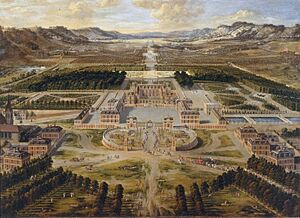
Louis XIV didn't pay much attention to Versailles until 1661. That year, he visited a super fancy party at the Château de Vaux-le-Vicomte, owned by his finance minister, Nicolas Fouquet. Louis XIV was amazed by the castle and its gardens. He was so impressed that he hired the same talented people who designed Fouquet's estate: architect Louis Le Vau, gardener André Le Nôtre, and painter Charles Le Brun.
Louis XIV wanted to make Versailles even grander than anything seen before. He personally oversaw the plans and construction.
Building the Palace
At first, work focused on the gardens. But in 1668, after a victory in a war, Louis XIV decided to turn Versailles into a huge royal home. He chose to build around his father's old castle instead of tearing it down. From 1668 to 1671, the old castle was covered on three sides with a new, fancy Italian-style building. This gave it a new look towards the gardens.
After Le Vau died, François d'Orbay continued the work. In the 1670s, they focused on the inside of the palace. They also started building a city around the palace, also called Versailles, to house all the government workers and courtiers.
In 1678, after another French victory in war, Louis XIV hired Jules Hardouin-Mansart as his main architect. Mansart had a big budget and many workers. He added the famous Hall of Mirrors from 1678 to 1681. He also built huge stables and a large building for servants and kitchens. Mansart added two completely new wings to the palace to house the many people at court.
Wars and money problems slowed down building for the rest of the 1600s. Work stopped completely during the Nine Years' War (1688-1697). Later, the War of the Spanish Succession (1701-1714) and bad harvests caused more money issues. Louis XIV had to cut funding. He and Mansart then focused on building a beautiful new palace chapel, which was finished in 1710.
Changes by Later Kings
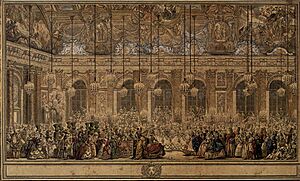
Kings Louis XV and Louis XVI mostly kept the palace as it was. They focused on updating the inside. Louis XV added a grand ballroom and expanded his private rooms. He also started building the Royal Opera of Versailles in 1748, but it wasn't finished until 1770 due to wars and money problems. His favorite, Madame du Barry, helped pay for some of the construction.
In 1771, Louis XV had one of the Ministers' Wings rebuilt in a new, simpler style. This was because the old one was falling apart! This work was also stopped by money issues. In 1789, the French Revolution forced the royal family to leave Versailles forever.
Versailles and French Power
The Palace of Versailles was super important for Louis XIV's power. It showed off French art and culture. It also helped him control the powerful noble families. Louis XIV held huge parties in the gardens to impress everyone. He wanted Versailles to be the center of his government.
By 1687, everyone knew Versailles was the real capital of France. Louis XIV made nobles come to Versailles to gain favor and prestige. This helped him reduce their power in their home regions. Important visitors from other countries, like ambassadors from Siam and Persia, were received at the palace.
Louis XIV died at Versailles in 1715. His great-grandson, Louis XV, became king. The court moved away from Versailles for a few years but returned in 1722. However, Versailles never quite had the same cultural power again.
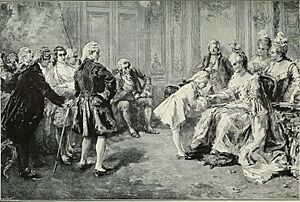
In 1763, a 7-year-old musical genius named Wolfgang Amadeus Mozart visited Versailles with his family. He played music for the King and later dedicated his first two piano sonatas to the King's daughter.
In 1783, important treaties were signed at the palace. These treaties officially ended the American Revolutionary War. While the main treaty was signed in Paris, Spain and France signed their agreements with Britain at Versailles.
On October 5, 1789, a huge crowd of thousands of people, mostly women, marched from Paris to Versailles. They were protesting the high price of bread. They surrounded the palace and forced the King, Queen, and government to return to Paris the next day.
After the royal family left, the palace was closed. In 1792, the new revolutionary government ordered all the art and sculptures to be moved to the Louvre museum. In 1793, they sold off almost everything inside the palace at auction. This included furniture, mirrors, and kitchen items. All royal symbols on the buildings were removed. The empty palace was used as a storage place.
Versailles in the 1800s
When Napoleon became Emperor in 1804, he thought about living at Versailles. But it was too expensive to fix up. He did restore the Grand Trianon nearby for his family to use as a spring home.
After Napoleon's defeat in 1815, Louis XVIII became king. He was Louis XVI's younger brother. He considered moving back to Versailles but realized the cost was too high.
In 1830, Louis Philippe I became king. He decided to turn the palace into a Museum of the History of France. This museum would celebrate "all the glories of France." Many of the old royal apartments were changed into large rooms and galleries. The most famous room is the Galerie des Batailles (Hall of Battles). It's filled with huge paintings of famous French victories.
Emperor Napoleon III sometimes used the palace for big events. In 1855, he hosted a fancy banquet for Queen Victoria in the Royal Opera of Versailles.

During the Franco-Prussian War (1870–1871), the German army took over the palace. Parts of it, like the Hall of Mirrors, became a military hospital. On January 18, 1871, the German Empire was officially created in the Hall of Mirrors. After the war, the new French government met in the palace's Opera House.
Versailles in the 1900s
Restoration work began in the late 1800s and early 1900s. This work was stopped by two World Wars but has continued ever since.
In June 1919, the palace was back in the spotlight. The Treaty of Versailles, which officially ended World War I, was signed in the Hall of Mirrors. Between 1925 and 1928, an American millionaire, John D. Rockefeller, Jr., gave a huge amount of money to help restore the palace.
After World War II, more restoration happened, including the Royal Opera of Versailles. It reopened in 1957 with Queen Elizabeth II of the United Kingdom present.
In the 1950s, the goal became to restore the palace to how it looked in 1789, when the royal family left. This included fixing the roof over the Hall of Mirrors. Many original furnishings have been bought back, which is very expensive because they are so rare.
Versailles Today
In 2003, a new big restoration project called "Grand Versailles" started. This included replanting over 10,000 trees in the gardens that were lost in a storm in 1999. The restoration of the Hall of Mirrors was finished in 2006.
The Palace of Versailles is still owned by the French government. It's managed by a special public group. The palace grounds hosted the horse riding events during the 2024 Summer Olympics.
Palace Design and Layout
The Palace of Versailles shows how French architecture changed from the 1630s to the 1780s. The oldest part was built for Louis XIII with brick, marble, and slate. Later, Le Vau added a new building around it, inspired by Italian villas. When Jules Hardouin-Mansart expanded the palace, he followed this new style.
The palace was mostly finished when Louis XIV died in 1715. It has a U-shape, with a large main courtyard called the Royal Court. Two huge wings stretch out, making the palace about 402 meters (1,319 feet) long. The palace has 2,143 windows, 1,252 chimneys, and 67 staircases!
Versailles and its gardens have inspired many other palaces and gardens around the world.
Royal Apartments: Where Kings and Queens Lived
When Louis Le Vau built the new part of the palace around Louis XIII's old castle, he added fancy apartments for the king and queen. These were called the Grand Apartments and were used for official events. The king and queen also had Private Apartments in the older part of the castle for their personal use.
The king's Grand Apartment had seven rooms, each named after a planet and a Roman god. The queen's apartment was similar. After the Hall of Mirrors was built, these apartments became smaller.
The queen's apartments were home to three French queens: Maria Theresa of Spain (Louis XIV's wife), Maria Leszczyńska (Louis XV's wife), and Marie Antoinette (Louis XVI's wife).
The Ambassador's Staircase
The Ambassador's Staircase was a grand staircase built from 1674 to 1680. It was the main entrance to the palace and the royal apartments. It was designed to amaze visitors with its tall, open space and natural light from a skylight.
The staircase was decorated with colorful marble, gold, and paintings. The artist Charles Le Brun painted scenes celebrating Louis XIV's victories. There were even trompe-l'œil paintings that made it look like people from around the world were looking into the staircase! Sadly, Louis XV had it taken down in 1752 to make room for his private apartments.
The King's State Apartments
These apartments were originally meant for the king to live in. But Louis XIV turned them into galleries for his best paintings and places for parties. During the colder months, parties were often held three times a week, with lots of entertainment.
The Salon of Hercules
This room was once a chapel. It was rebuilt to show off two huge paintings by Paolo Veronese. The ceiling painting, The Apotheosis of Hercules, gives the room its name.
The Salon of Venus
This room was used for serving snacks during evening parties. It features a life-size statue of Louis XIV dressed as a Roman emperor. The ceiling painting shows the goddess Venus.
The Salon of Mercury
This was Louis XIV's official bedroom when he moved his court to Versailles in 1682. The bed you see today is a copy. The ceiling paintings show the god Mercury and famous historical figures. There's also a special clock that, when it chimes, shows figures of Louis XIV and Fame coming down from a cloud!
The Salon of Apollo
This was Louis XIV's throne room. It was where he held formal meetings. The original silver throne was melted down in 1689 to help pay for a war. The ceiling painting shows the Sun Chariot of Apollo, which was the king's favorite symbol.
The Salon of Diana
Louis XIV used this room as a billiards room. Courtiers could watch him play from galleries. The famous bust of Louis XIV by Bernini is displayed here.
Private Apartments of the King and Queen
The King's Private Rooms
These rooms were the heart of the palace. They were in the same spot as Louis XIII's original rooms. Louis XIV and later kings used them for personal activities and official ceremonies, like the daily "waking up" and "going to bed" of the king. Many courtiers would watch these events!
The King's bedchamber was originally a drawing room. Louis XIV turned it into his bedroom in 1701 and passed away there in 1715. Louis XVI and Marie-Antoinette stood on the balcony of this room on October 6, 1789, looking at the angry crowd before they were forced to leave for Paris.
The Queen's Private Rooms
These rooms were just for the queen's personal use. They were first designed for Maria Theresa of Spain, Louis XIV's wife. Later, Marie Leszczyńska and Marie Antoinette used them. The queen's apartments were similar in layout to the king's, with ceilings painted with scenes of female figures from mythology.
The Amazing Hall of Mirrors
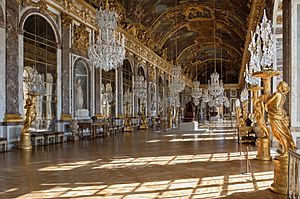
The Hall of Mirrors is one of the most famous rooms in the palace. It's a long gallery that looks out over the gardens. It was built from 1678 to 1681. The hall has 578 mirrors that face 17 windows, reflecting the light and making the room sparkle!
The ceiling is covered with a huge painting by Le Brun. It shows the first 18 years of Louis XIV's reign, including 17 military victories. The painting shows Louis XIV himself, along with figures from ancient stories.
At each end of the Hall of Mirrors are two special rooms: the Salon of War and the Salon of Peace. The Salon of War celebrates French victories with marble and gold decorations. The Salon of Peace is decorated in a similar way but focuses on themes of peace.
The Royal Chapel
The Royal Chapel is a beautiful church inside the palace. It's 40 meters (131 feet) high! The chapel mixes traditional French church design with the fancy French Baroque style of Versailles. The ceiling has three amazing paintings. These paintings celebrate the actions of King Louis IX and include images of other important historical figures.
Louis XIV ordered this chapel to be built. It was the last major building project during his reign. Construction started in 1699 and finished in 1710. The chapel was fully restored from late 2017 to early 2021.
The Royal Opera House
Louis XIV first wanted an opera house in 1682, but it was too expensive because of his wars. The idea came back under Louis XV, with a new design by Ange-Jacques Gabriel. It was finally built quickly for the wedding of the future Louis XVI and Marie Antoinette.
To save money and time, the opera house was built almost entirely of wood. This also made the sound quality (acoustics) very good! The wood was painted to look like marble. The ceiling has a painting of Apollo, the god of arts. The new Opera House opened on May 16, 1770, for the royal wedding.
In October 1789, just before the French Revolution, the last royal banquet was held here. After a war in 1871, the French government met in the opera house for a few years.
Museum of French History
-
The Battle of Taillebourg, by Eugène Delacroix (1837)
-
Louis Philippe and his sons at the gates of Versailles (1846)
After becoming king in 1830, Louis Philippe I decided to turn the palace into a museum. It was dedicated to "All the Glories of France." Many of the old royal apartments were changed into large rooms and galleries.
The most famous room is the Hall of Battles, which shows huge paintings of French victories. Other rooms display famous paintings of French history and heroes. Some paintings were brought from the Louvre, and others were specially painted for the museum.
Louis Philippe's plans for the museum stopped when he was overthrown in 1848. But the Gallery of Battles is still there for visitors to see. Today, some rooms also tell the history of the palace itself, with videos and models.
The Grand Estate of Versailles
The entire area of Versailles includes the palace, other buildings around it, and its huge park and gardens. As of June 2021, the whole estate covers about 800 hectares (nearly 2,000 acres). The gardens are to the south, west, and north of the palace.
The estate was first a hunting spot for Louis XIII. Louis XIV expanded it greatly. At its biggest, the hunting grounds were about 15,000 hectares (37,000 acres)! A 40-kilometer (25-mile) long wall with 24 gates surrounded the estate.
The land was originally a swamp, so it took a lot of work to create the beautiful landscape. They moved earth, built terraces, and created lakes and ponds. Getting enough water for the palace, city, and gardens was a huge challenge. They even built a giant pumping station from the Seine river!
The Famous Gardens
The gardens of Versailles, as we see them today, were designed by André Le Nôtre for Louis XIV. He created a very orderly and grand design with straight paths, flowerbeds, hedges, and many ponds and lakes. These gardens became the perfect example of the "French formal garden" style and have been copied all over the world.
Other Buildings on the Estate
One of the first extra buildings was the Versailles Menagerie, built from 1662 to 1664. It was a royal zoo! The Versailles Orangery, south of the palace, was built to store orange trees and other delicate plants during winter.
Louis XIV also had the Château de Marly built as a private retreat. It had a main building and twelve smaller pavilions. It was later sold and torn down, but the land is now part of the Versailles estate again.
La Lanterne is a hunting lodge built in 1787. Since 1960, it has been a state residence for important guests.
The Petit Trianon
The Petit Trianon was built for Louis XV and his favorite, Madame du Barry, from 1762 to 1768. It's a beautiful building in a simpler, Neoclassical style. When Louis XVI became king, he gave the Petit Trianon to Marie Antoinette. She changed its gardens to a more natural English style and created her own small court there.
Before this, Louis XIV had a "Porcelain Trianon" built in 1670. It was the first example of Chinese-inspired architecture in Europe, but its roof leaked, so it was torn down.
The Grand Trianon
-
The Grand Trianon with courtyard and gardens. The wing at left is a residence of the President of France.
To replace the Porcelain Trianon, Louis XIV had the Grand Trianon built in 1687. It was made of marble in just three months! It has one story and beautiful gardens. The inside is mostly original. Louis XIV, Marie Leszczyńska, and Napoleon all lived here. Today, one wing of the Grand Trianon is a residence for the President of France.
The Queen's Hamlet and Theatre
Near the Trianons are the French Pavilion and the Queen's Theatre. The Queen's Theatre was built for Marie Antoinette in 1780. It's hidden in the gardens and is still in its original state.
Marie Antoinette also had the Queen's Hamlet built from 1783 to 1785. This was like a small, rustic village with a farmhouse, dairy, and a mill. She wanted a simpler, country-like place within her gardens. The farm even produced milk and eggs for the queen!
Versailles Today: Politics and Ceremonies
The palace is still used for important political events. World leaders are sometimes hosted in the Hall of Mirrors. The French Parliament (made up of the Senate and the National Assembly) meets in Versailles for special joint sessions. They do this to change or update the French Constitution. This tradition started in 1875.
In 2009, President Nicolas Sarkozy gave a speech about the economy to Parliament in Versailles. This was the first time a president had done this since 1848. After the Paris attacks in November 2015, President François Hollande also gave a speech to a joint session of Parliament at the palace. In 2023, King Charles III of the United Kingdom had a state banquet at the Palace during his visit to France.
Images for kids
See also
 In Spanish: Palacio de Versalles para niños
In Spanish: Palacio de Versalles para niños
- Bureau du Roi
- Fresh pavilion
- List of Baroque residences
- List of tourist attractions in Paris
- Louis XIV style
- Paris Peace Conference, 1919
- Potager du roi, Versailles (Kitchen Garden of the King)
- Tennis Court Oath (French: serment du jeu de paume) in the Saint-Louis district
- Versailles Cathedral
- Éléphante de Louis XIV



